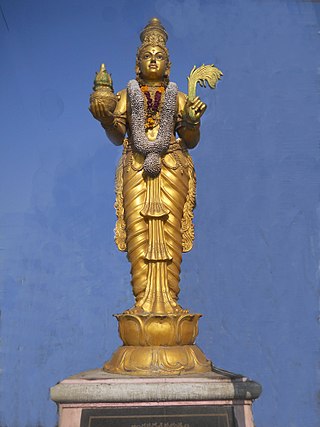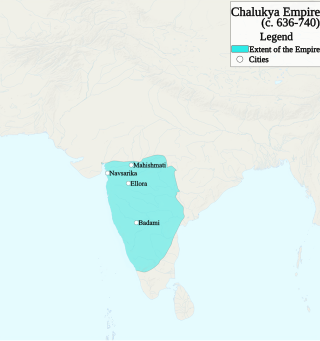
The Pallava dynasty existed from 275 CE to 897 CE, ruling a significant portion of the Deccan, also known as Tondaimandalam. The Pallavas played a crucial role in shaping in particular southern Indian history and heritage. The dynasty rose to prominence after the downfall of the Satavahana Empire, whom they had formerly served as feudatories.

Kosala, sometimes referred to as Uttara Kosala was one of the Mahajanapadas of ancient India. It emerged as a small state during the Late Vedic period and became one of the earliest states to transition from a lineage-based society to a monarchy. By the 6th century BCE, it had consolidated into one of the four great powers of ancient northern India, along with Magadha, Vatsa, and Avanti.
Ikshvaku is a legendary king in Indian religions, particularly Hindu and Jain mythologies. In Hinduism, he is described to be the first king of the Kosala kingdom, and was one of the ten sons of Shraddhadeva Manu, the first man on the earth. He was the founder and first king of the Ikshvaku dynasty, also known as the Suryavamsha, in the kingdom of Kosala, which also historically existed in ancient India. He had a hundred sons, among whom the eldest was Vikukshi. Another son of Ikshvaku's, named Nimi, founded the Kingdom of the Videhas. Rama, Mahavira, and the Buddha are also stated to have belonged to the Suryavamsha or Ikshvaku dynasty.

Telugu people, also called Andhras, are an ethno-linguistic group who speak the Telugu language and are native to the Indian states of Andhra Pradesh, Telangana and Yanam district of Puducherry. They are the most populous of the four major Dravidian groups. Telugu is the fourth most spoken language in India and the 14th most spoken native language in the world. A significant number of Telugus also reside in the Indian states of Karnataka, Tamil Nadu, Orissa, Maharashtra. Members of the Telugu diaspora are spread across countries like United States, Australia, Malaysia, Mauritius, UAE, and others. By 2024 Telugu is spoken by 95.7 million people all over world, which makes it the third largest Indian diaspora after Hindi and Bengali. Telugu is the fastest-growing language in the United States. It is also a protected language in South Africa.

The Āndhras were an ancient tribe of south-central Indian subcontinent, whose existence is attested during the Iron Age. Andhras were mentioned in the ancient Hindu scriptures such as the Aitareya Brahmana, Ramayana, Mahabharata and Puranas. The kingdom inhabited and ruled by Andhras was called Andhra, and was based in the Deccan region. The modern Indian state of Andhra Pradesh, derives its name from this historic tribe and region.
The Bruhat Palayanas were an ancient Indian dynasty based in the modern state of Andhra Pradesh. They ruled Northern Andhra with Pithunda, near Machilipatnam as the capital after the Ikshvakus around the third century. Jaya Varma was the only known Bruhatpalayana ruler. A princess of his family was married to the Andhra Ikshvaku king. His Kingdom included Musala Taluk as far as Gudivada, Kolleru and northern parts of Guntur. He gave the village of Patur in Tenali Taluk to eight Brahmins. After his death the Ananda Gotrikas occupied his territory to the south of the Krishna river and the Salankayanas took his territory north of the river.

The Salankayana dynasty of ancient India ruled a part of Andhra region in India from 300 to 440 CE. Their territory was located between the Godavari and the Krishna rivers. Their capital was located at Vengi, modern Pedavegi near Eluru in West Godavari district of Andhra Pradesh.
Ananda Gotrikas, also referred to as Anandas ruled coastal Andhra with Kandarapura as the capital from 335-425 AD. Their capital is located in present day Chejerla mandal of Guntur District. The Ananda Gotrikas ruled after the fall of the Andhra Ikshvakus and claimed descent from the Ananda gotra.

Eastern Chalukyas, also known as the Chalukyas of Vengi, were a dynasty that ruled parts of South India between the 7th and 12th centuries. They started out as governors of the Chalukyas of Badami in the Deccan region. Subsequently, they became a sovereign power, and ruled the Vengi region of present-day Andhra Pradesh until c. 1001 CE. They continued ruling the region as feudatories of the Medieval Cholas until 1189 CE.
The Andhra Ikshvaku dynasty ruled in the eastern Krishna River valley of India, from their capital at Vijayapuri for over a century during 3rd and 4th centuries CE. The Ikshvakus are also known as the Ikshvakus of Vijayapuri to distinguish them from their legendary namesakes.

Nagarjunakonda: Nāgārjunikoṇḍa, meaning Nagarjuna Hill) is a historical town, now an island located near Nagarjuna Sagar in Palnadu district of the Indian state of Andhra Pradesh. It is one of India's richest Buddhist sites, and now lies almost entirely under the lake created by the Nagarjuna Sagar Dam. With the construction of the dam, the archaeological relics at Nagarjunakonda were submerged, and had to be excavated and transferred to higher land, which has become an island.

Shitalanatha was the tenth tirthankara of the present age according to Jainism. According to Jain beliefs, he became a siddha, a liberated soul which has destroyed all of its karma. Jains believe Shitalanatha was born to King Dradhrath and Queen Nanda at Bhaddilpur into the Ikshvaku dynasty. His birth date was the twelfth day of the Magha Krishna month of the Indian national calendar. Shitalanatha is associated with Svastika (Dig.)/ Srivatasa (Svet.) emblem, Pilurikha tree, Brahma Yaksha and Manavi (Dig.) & Ashoka (Svet.) Yakshi.

Vimalanatha was the thirteenth Jain Tirthankara of the present age (Avasarpini). According to Jain beliefs, he became a Siddha, a liberated soul which has destroyed all of its karma. Vimalanatha was born to King Kratavarma and Queen Shyamadevi at Kampilya of the Ikshvaku dynasty. His birth date was the third day of the Magh Sukla month of the Indian calendar.
The Solar dynasty or Sūryavaṃśa, also called the Ikshvaku dynasty is a legendary Indian dynasty said to have been founded by Ikshvaku. In Hindu literature, it ruled the Kosala Kingdom with their capital at Ayodhya and later at Shravasti. They prayed to their clan deity Surya, after whom the dynasty formed its namesake. Along with the Lunar dynasty, the Solar dynasty comprises one of the main lineages of the Kshatriya varna in Hinduism.

The recorded history of Andhra Pradesh, one of the 28 states of 21st-century India, begins in the Vedic period. It is mentioned in Sanskrit epics such as the Aitareya Brahmana. Its sixth-century BCE incarnation Assaka lay between the Godavari and Krishna Rivers, one of sixteen mahajanapadas. The Satavahanas succeeded them, built Amaravati, and reached a zenith under Gautamiputra Satakarni.
Several Branches of the Rashtrakuta dynasty were created by the kings, commanders and relatives of the Rashtrakuta family during their expansion into central and northern India in the eighth to the tenth centuries. These kingdoms ruled during the reign of the parent empire or continued to rule for centuries after its fall or came to power much later. Well known among these were the Rashtrakutas of Gujarat (757-888), the Rattas of Saundatti (875-1230) in modern day Karnataka, the Rashtrakutas of Rajasthan and ruling from Hastikundi or Hathundi (893-996), Dahal, the Rathores of Mandore and Dhanop, Reddy dynasty of Andhra Pradesh and Telangana, Rashtraudha dynasty of Mayuragiri in modern day Maharashtra and Rashtrakutas of Kanauj.
The Western Ganga Dynasty ruled large parts of southern Karnataka from the fourth century CE till the late tenth century CE with their regal capital initially at Kolar and later at Talakad in Mysore district, Karnataka. The origin of the Ganga clan prior to the fourth century is shrouded in legends and myths. Clarity into their history comes from such contemporaneous writings as Chavundaraya Purana in Kannada and Lokhavibhaga in Prakrit and from numerous inscriptions excavated in the Mysore, Bangalore and Kolar districts and Anantapur district. The Western Gangas played a pivotal role in the development of polity, culture and literature during their long rule in the region, at times as independent monarchs and at other times as subordinates of their larger neighbors: the Badami Chalukyas and later the Rashtrakutas of Manyakheta. Their patronage to literature in Kannada and Sanskrit, their achievements in architecture including the famous monolith of Gomateshwara, their Hindu temples in the southern Karnataka, and their Jain Basadi's of Shravanabelagola and Kambadahalli are testimony to the rich contribution they made to the region.
The Bana or Vana was a dynasty based in South India, who claimed descent from king Mahabali. The dynasty takes its name from Bana, the son of Mahabali. The Banas faced opposition from several neighbouring dynasties and served some major dynasties such as the Chalukyas Cholas and Pandyas as feudatories, sometimes after they were subjugated by them. They also served as Samantas to some dynasties. The Banas had their capital at various places at different times, including Kolar and Gudimallam.

The Chalukya dynasty was a Classical Indian dynasty that ruled large parts of southern and central India between the 6th and the 12th centuries. During this period, they ruled as three related yet individual dynasties. The earliest dynasty, known as the "Badami Chalukyas", ruled from Vatapi from the middle of the 6th century. The Badami Chalukyas began to assert their independence at the decline of the Kadamba kingdom of Banavasi and rapidly rose to prominence during the reign of Pulakeshin II. After the death of Pulakeshin II, the Eastern Chalukyas became an independent kingdom in the eastern Deccan. They ruled from Vengi until about the 11th century. In the western Deccan, the rise of the Rashtrakutas in the middle of the 8th century eclipsed the Chalukyas of Badami before being revived by their descendants, the Western Chalukyas, in the late 10th century. These Western Chalukyas ruled from Kalyani until the end of the 12th century.

Ayodhya is a legendary city mentioned in the ancient Sanskrit-language texts, including the Ramayana and the Mahabharata. These texts describe it as the capital of the Ikshvaku kings, including Rama.










